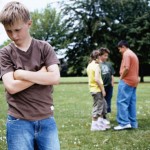di p. Luciano Sandrin, tratto da “Capire il malato. Lo sguardto della psicologia“, Edizioni Camilliane, Torino, 2014
‘Many years ago my family used to go to a church near to our home’: this is the beginning of a book with a very important title and one that can be understood by those who do not speak English: Vulnerable Communion. The author relates that one a day a group of mothers went to the pastor of the community and expressed their anger about the ‘bad’ behaviour of a child who went to the Sunday school: explosions of anger, a lack of respect for the space of other people, to the point of hitting the other children when he was irritated or provoked. And after expressing their indignation these mothers asked the pastor to call the parents of the child and ask them to stop taking him to the Sunday school.
The ‘problem-child’ was Chris, the son of the author. His wife received the telephone call of the pastor who apologised and was kind, but the damage had been done. For many years they had followed various therapeutic programmes and family counselling. The child had been diagnosed as having Asperger’s syndrome, a grave development disorder linked to autism and characterised by important difficulties in social interaction.
After that telephone call the parents stopped going to that church but they also stopped meeting those mothers and the pastor himself. But in their opinion the situation could have been addressed differently: the other parents could have spoken directly with them in an attempt to understand, to create friendships, to offer them help and to promote forms of support. And to create bridges rather than raising barriers that excluded.
Through the loving presence of very many people they were moving out of an isolation that had been self-imposed in order to protect themselves against the pain of being excluded, against the shame of being shown to be an ‘atypical family’, constantly bombarded by unhappy comments by people who, albeit with the best intentions, reinforced in them a feeling of being ‘bad parents’. Through this self-isolation they also tried to protect Christ from the pain of ‘not being understood’ and being ‘maltreated’. But these walls of protection created further suffering because they impeded those relationships that could offer friendship and support. It was like a vortex from which they were emerging through the hospitality of friends, the care of health-care professionals and a church community that wanted their good. And through all these people they experienced the love of God. This last exclusion, this denied access, excluded them even more and made them turn back.
The birth of a child that has a disability, especially if grave, is like waking up suddenly from a dream. The child that was dreamed for is no longer there. There is a child with a ‘real’ disability. And the family must engage in a journey of mourning, abandon its dream and look a different reality in the face: loving a child who, through her or her birth, may have let down projects and wishes. Many families do this and express a special strength, a capacity to resist, to face up to a problem and grow. And they come to love their ideal child.
For other families the pathway of acceptance is not an easy one, and at times it lasts a lifetime. Some families do not accept a disabled and real child. Or simply they conceal that child. And on this pathway of difficult adaptation and troubled acceptance, most of the time, these families are left on their own: isolated families that tend to isolate themselves, families that break friendships and thus lose an opportunity to allow themselves to be helped in addressing a thousand daily problems.
Some families live as though they are blocked by a single task: taking care of their child. Those who pay for this can only be the couple themselves in their lives, the growth of their other children and also the disabled child himself or herself who pays the price of ‘excess help’ which prevents that child from growing and expressing the level of independence of which he or she is capable.
What one should do is first of all help these families to avoid isolation: linking the parents to the community’s organisations is a means by which to face up in a serious way to the daily problems connected with disability, social barriers and consequent marginalisation. At times the silence that surrounds the world of disability can be broken by appropriate celebrations in which the level of anger, spoken or sung, becomes a prayer and can be a moment of liberation. And everything should be mediated through the presence of a community which, if it has removed the steps that prevent entrance into buildings made of stone, has above all thrown down the many and invisible mental barriers that impede a child with disability and his or her family from gaining access to social life and the life of the Church.















Camillians on Facebook
Camillians on Twitter
Camillians on Instagram